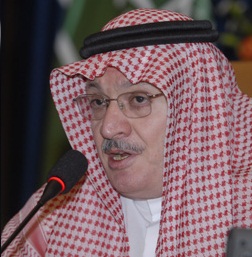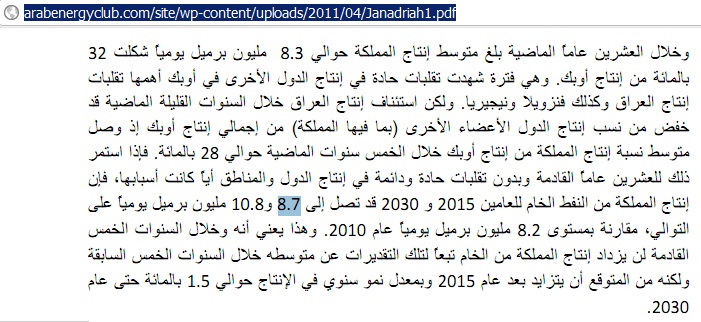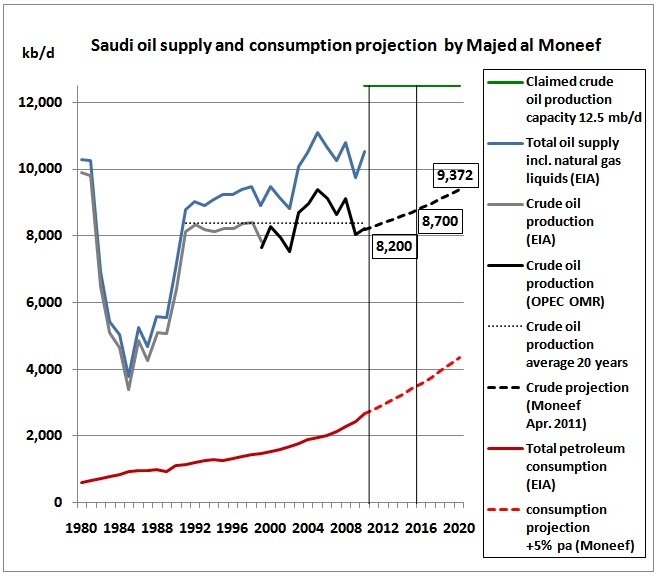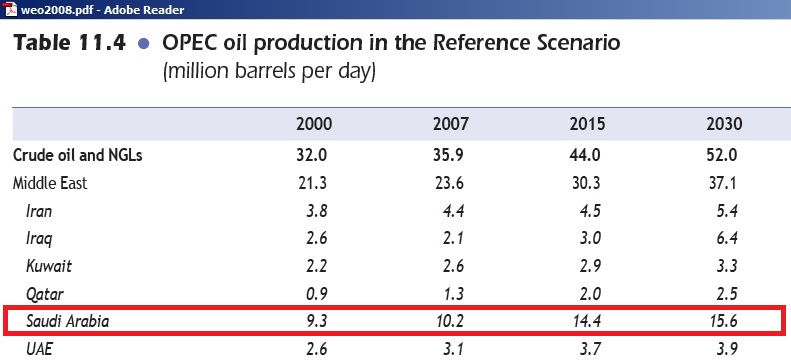Saudi Arabia’s crude oil production will not increase beyond an average level of 8.7 mb/d (average last 20 years: 8.3 mb/d) until 2015. This is what OPEC Governor Majed al Moneef said when releasing a new research paper published on  the web site of the Arab Energy Club and quoted by Platts. As Saudi’s domestic petroleum consumption (2010: 2.7 mb/d) is expected to grow by 5% each year this implies that Saudi oil exports will shrink by around 10% in the next 4-5 years. There is little consolation that Moneef promised that production would increase after 2015 to 10.8 mb/d in far away 2030, by 1.5% pa. A claimed capacity of 12.5 mb/d seems elusive, whether now or in 2 decades.
the web site of the Arab Energy Club and quoted by Platts. As Saudi’s domestic petroleum consumption (2010: 2.7 mb/d) is expected to grow by 5% each year this implies that Saudi oil exports will shrink by around 10% in the next 4-5 years. There is little consolation that Moneef promised that production would increase after 2015 to 10.8 mb/d in far away 2030, by 1.5% pa. A claimed capacity of 12.5 mb/d seems elusive, whether now or in 2 decades.
We now have the 3rd major warning of Saudi officials on the limits to Saudi oil production. In 2006, Platts quoted a Saudi spokesman explaining that Saudi oil fields have a composite decline rate of 2% pa. In 2007, ex-Saudi Aramco chief Sadad-al-Husseini presented production profiles to an Oil&Money conference in London implying a production of 11 mb/d in the 2nd half of the current decade. This now seems to have been too optimistic. Will governments listen this time and accept that our oil based car culture will come to an end in the not too distant future?
Extract from the research paper. An English translation is not available yet, but the years 2015 and 2030 can be clearly related to 8.7 and 10.8 mb/d respectively (from right to left)
Let’s go through the Platts article “Saudi Arabia sees output at 10.8 mb/d by 2030: official”
http://www.platts.com/RSSFeedDetailedNews/RSSFeed/Oil/8812036
and put the statements into graphs.
(1) “Majed Al Moneef, Saudi Arabia’s OPEC governor, said in the paper published on the Arab Energy Club website that Saudi output averaged 8.2 million b/d in 2010.”
Saudi crude production from various sources>>
Moneef’s average of 8.2 mb/d is calculated from OPEC’s Monthly Oil Market Report (OMR). We see that IEA’s curve is much higher and EIA’s is completely out of the rest.
.
.
(2) “If this trend [decline of Saudi share in OPEC oil production from 32% to 28%] continues in the next 20 years without any sharp fluctuations in production from other producing states, the kingdom’s crude oil output in 2015 and 2030 could rise to 8.7 million b/d and 10.8 million b/d respectively, compared with an average 8.2 million b/d in 2010,” he said.
(3) “This means that during the next five years, the kingdom’s crude oil production will not rise but will start to increase after 2015 at an annual rate of around 1.5 percent to 2030,” Moneef said.
There is a contradiction here in these 2 statements for the period to 2015. Either production rises from the 2010 level of 8.2 mb/d to 8.7 mb/d in 2015 or it does not rise and stays at 8.2 mb/d. For the benefit of doubt we assume here that production could rise.
(4) Given that the kingdom has total production capacity of 12.5 million b/d, of which 72% is currently being exploited, actual production to end 2030 will be maintained at this assumed level within this available capacity, he added.
 << this is a slide by Saudi Aramco’s Nansen G Saleri in a presentation at CERA Week in Houston in February 2007 showing oil projects and a planned capacity of 12 mb/d by 2010 plus a growing outlook symbolised by a rising crescent.
<< this is a slide by Saudi Aramco’s Nansen G Saleri in a presentation at CERA Week in Houston in February 2007 showing oil projects and a planned capacity of 12 mb/d by 2010 plus a growing outlook symbolised by a rising crescent.
MSC stands for “maximum sustainable capacity”.http://www.peakoil.net/MSC.html
The original link to the PDF file is broken and points to the following IHS site
.
http://www.ihs.com/products/cera/index.aspx
Let’s see how actual production and Moneef’s revised projection fit into Saleri’s graph:
Both actual production and Moneef’s projection are in the lower part of the window. The grey line shows the maximum monthly production ever achieved during the respective calendar year. We see that the claimed spare capacity (the difference between production and “maximum sustainable capacity”) has never been utilised, not even in July 2008, the peak month with 9.5 mb/d and the highest oil prices of that year.
Also included in the graph is Sadad-al-Hussein’s projection from 2007, somewhere between Saleri’s MSC and the revised projection. The trend is clear: we are going down. Get prepared for more surprises.
Details on Husseini’s projection can be found in this earlier post:
2/3/2011 WikiLeaks cable from Riyadh implied Saudis could pump only 9.8 mb/d in 2011
http://www.crudeoilpeak.com/?p=2669
These downward revisions also mean the assumptions by the IEA are outdated.
This table from the IEA’s World Energy Outlook 2008 shows the illusionary oil production numbers for 2015 through to 2030.
(5) The anticipated 1.5% annual increase in production by OPEC and Saudi Arabia will meet global oil demand as well as local demand for oil and refined products, he said. Demand growth in OPEC has been growing at a rate of 3% and in Saudi Arabia at 5% a year in the past 20 years, Moneef said.
This graph shows Saudi petroleum consumption growth rates over a period of 20 years. The average is 4.5% but can vary annually between 3% (2006) and +9% (2010)
(6) “If this rate of growth continues in line with economic and population growth as well as demand for power generation, water and transport, then a larger proportion of production will be directed gradually toward meeting domestic demand, which is rising at a higher rate than expected average output growth, which will reduce the volume available for export,” Moneef said.
http://www.opec.org/opec_web/static_files_project/media/downloads/publications/MOMR_April_2011.pdf
The above graph is an example of oil demand growth from OPEC’s April 2011 report, running at an annual 135 kb/d. By 2015, Saudi Arabia will have increased its oil demand by an astonishing 740 kb/d, 50% more than Australia’s entire crude imports in 2010. One of the reasons mentioned by Moneef is the power requirement for desalination and we may remember this article in the Oildrum:
Peak water in Saudi Arabia
These news come as a surprise, but not so much. Saudi Arabian food production has been based on “fossil water.” It is water from ancient aquifers that can’t be replaced by natural processes in times of interest for human beings. Fossil water is non renewable, just as oil is, and it is unavoidable that it has to run out one day or another.http://www.theoildrum.com/node/3520
(7) “This means that the value of exports [and revenues] will depend primarily on global oil prices and not on the volume of production and exports. This is not a new development but will become clearer over the next two decades,” he added.
Welcome to a new world of oil prices. As Jeff Rubin is saying, only a recession stands in the way of $200 oil.
Policy implications:
It is ever more urgent that Governments stop oil dependent projects like toll-ways and start infrastructure projects which get us away from oil, like electric rail. It is also the duty of care of governments to inform the public about these oil statistical facts and to prepare motorists for some tough times ahead.
Links and further reading:
CV of Majed Al-Moneef, Governor for Saudi Arabia, OPEC Board of Governors
http://www.erf.org.eg/cms.php?id=erf_affiliates_research_fellows_details&affiliates_id=21
http://www.iisd.ca/ymb/cdmsa/pix/21sept/3moneef_s.jpg
Disquieting Saudi Oil Indicators and the next oil shock
http://earlywarn.blogspot.com/2011/04/disquieting-saudi-oil-indicators-and.html
Only a recession stands in the way of $200 oil.
http://www.jeffrubinssmallerworld.com/2011/03/02/only-a-recession-stands-in-the-way-of-200-oil/
13/8/2010 Saudi Arabia lost production share to Russia
http://www.crudeoilpeak.com/?p=1800
31/7/2010 Saudi Aramco’s crude oil exports peaked in 2005
http://www.crudeoilpeak.com/?p=1738





